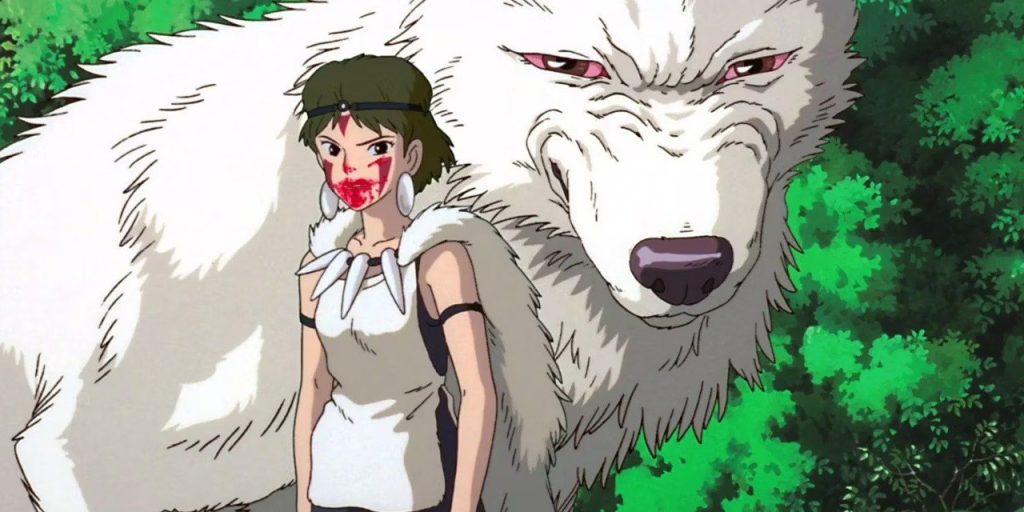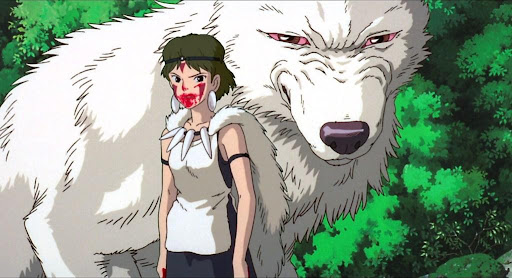Blog
Princess Mononoke – A Great Present from Ghibli Studio
The reasons I want to review this movie are several. Here is one of them. I always want to talk about something not available in the real world, stories where myth and dreams are set free to play. I realize only animation can open that possibility because it is freed from gravity and the chains of the possible. Live-action films show the world in a physical way; animation films show the fiction and hopes for a better life.
Actually, animated films are not copies of “real movies,” they are not shadows of reality but create a new world. True, a lot of animation is insipid, and insulting even to the children it is made for. But great animation can make the mind sing.
Hayao Miyazaki is a good animator, and his “Princess Mononoke” is a great film, too. Do not allow conventional thoughts about animation to prevent you from seeing it. It tells an epic story set in medieval Japan, at the dawn of the Iron Age, when some men still lived in harmony with nature and others was trying to tame and beat it. It is not a simplistic tale of good and evil, but the story of how humans, forest animals, and nature gods all fight for their lives and the place to settle down. It is one of the most creative films I have ever seen.
The movie opens with a watchtower guard spotting “something wrong in the forest.” There is a disturbance of nature, and out of it leaps a remarkable creature, a kind of boar monster with flesh made of writhing snakes. It comes to attack the villagers, and to the defense comes Ashitaka, the young prince of his isolated people. He is finally able to slay the beast, but his own arm has been wrapped by the snakes and is horribly scarred.
A smart woman is able to explain what has happened. The monster was a boar god, until a bullet buried itself in its flesh and drove it mad. And they wonder where did the bullet come from? “It is time,” says the woman, “for our last prince to cut his hair and leave us.” And so Ashitaka starts on a long journey to the lands of the West, to find out the destination to treat the pain and the place where can help the villagers.
Along the way, there are strange sights and adventures and the quality of Miyazaki’s artistry is appreciated very much. The drawing is not too easy, but it contains some of the same “clear line” complexity used by the traditional Japanese graphic artists of two centuries ago, who inspired such modern works as Herge’s Tintin books. Nature is rendered majestically (Miyazaki’s art directors experienced ancient forests to create their master drawings) and fancifully (as with the round little forest sprites). There are also quick, mysterious appearances of the spirit of the forest, who in daylight seems to be a noble beast, but at nighttime a glowing light.
Ashitaka eventually comes to an area that is prowled by Moro, a wolf god, and sees for the first time the young woman named San. She is also known as “Princess Mononoke,” but that’s more than a name; a Mononoke is really the spirit of a beast. San was a human child, raised as a wolf by Moro; she rides bareback on the swift white spirit wolves and helps the pack in their battle against the encroachments of Lady Eboshi, a powerful ruler whose village is developing ironworking skills and manufactures weapons using gunpowder.
As Lady Eboshi’s people can gain reasonable knowledge, they lose others, and in the day is fading when men, animals and the forest gods all speak the same language. Slaves work the bellows of the forges, and lepers make the weapons.
But all isn’t black and white. The lepers are grateful that Eboshi accepts them. Her people enjoy her protection. Even Jigo, a scheming agent of the emperor, has motives that sometimes make a certain amount of sense. When a close-by samurai enclave wants to control the village and its technology, there is a battle with more than one side and more than one motive. This is often more like mythical history than action melodrama.
The artistry in “Princess Mononoke” is really masterful. The painful skin of the boar monster is a really special sight, one that you can not see in other live-action films. The huge white wolves show their appreciation, and are not sentimentalized; when they bare their fangs, you can see that they are not friendly comic pals, but animals who can and will kill.
Miyazaki and his co-workers work at Japan’s Studio Ghibli, several years ago, Disney bought the studio’s entire output for worldwide distribution. (Disney artists consider Miyazaki a root of inspiration.) The contract said Disney could not change a frame–but there was no intention to dub into English, because, well, all animation is dubbed into even its source language, and as Miyazaki cheerfully observes, “English has been dubbed into Japanese for years.”
The version of “Princess Mononoke” has been well prepared and carefully released with numerous vocal talents, including Billy Crudup as Ashitaka, Claire Danes as San, Minnie Driver as Eboshi, Gillian Anderson as Moro, Billy Bob Thornton as Jigo, and Jada Pinkett-Smith as Toki, a normal working woman in the village.
The drama is produced with Miyazaki’s deep humanism, which avoids easy moral simplifications. There is a highlighted scene where San and Ashitaka, who together create love, agree that they can’t control the lives of others, so they must give each the freedom, they can only meet sometimes. “Princess Mononoke” is a meaningful movie and worth watching, and it is considered as one of the best films of the year.
The information about the movies is inspired by the new book, “Hayao Miyazaki: Master of Japanese Animation,” by Helen McCarthy (Stone Bridge Press, $18.95).
By: Roger Ebert
Cre: https://www.rogerebert.com/reviews/princess-mononoke-1999
https://en.wikipedia.org/wiki/Princess_Mononoke
https://ghibli.fandom.com/wiki/Princess_Mononoke



